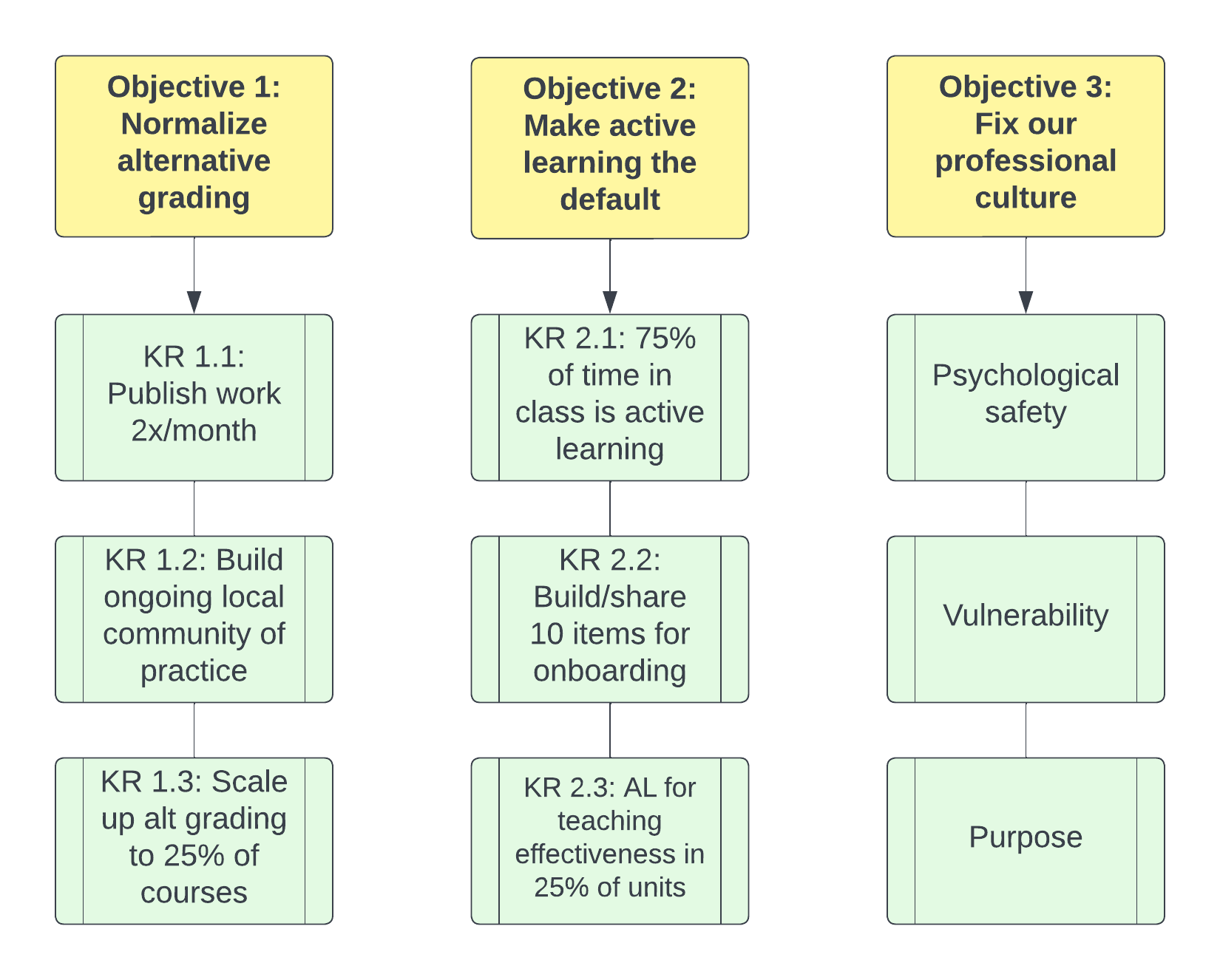Grand questions about grand challenges

This afternoon I had the pleasure of giving one of the keynotes for the Teaching Experiment Academy (TEA) Summit. The TEA consists of STEM faculty from a group of California universities, all committed to a year-long process of redesigning their courses around mastery learning and alternative grading systems. Last year as the TEA was just getting started, I gave a talk on alternative grading systems as fuel for the group's work. Today, I wanted to give them a sense of what could be next, so I spoke on Three Grand Challenges for Higher Ed STEM Teaching.
The three Grand Challenges are:
- Challenge 1: Normalize alternative grading.
- Challenge 2: Make active learning the default.
- Challenge 3: Fix our professional culture.
Since each of these Grand Challenges are, well, grand, I used the Objectives and Key Results (OKR) framework to break them down into specific tasks with quantitative measures – except for the third one, where quantification didn't really work.

I'm going to save a recap of this talk, including all the details on those key results, for next week. We ran short on time and I wasn't able to address any of the questions the audience left in the backchannel, so today's post is me answering all those questions, and I'll give context when necessary.
In particular, Key Result 1.1 enjoined the audience to publish 24 blog posts about their alternative grading experiments over the next 12 months. A bunch of folks felt very little confidence they could do this because of time pressure; in order to eat some of my own dog food, I promised them I would have a blog post up within two hours of the end of the talk with answers to their questions. So here we go!
Q: (About Key Result 1.1, "Publish 24 blog posts over the next 12 months") I can't come up with even 10 different places I could publish. Where are all these places that I'm missing?
A: I think this got sorted out in the chat, but I don't mean publish articles in 24 different journals. We're not talking journals here. I mean: Start your own blog (or contact me about guest-posting at gradingforgrowth.com) and publish there 24 times. That's an average of twice a week each month for a year. Keep it to 750 words so it's not a tremendous amount of work. Don't overthink it and do NOT make it perfect. Just dump your thoughts into the editor, correct as many straight-up typos as you can find, and hit "Publish" and be done with it.
But I don't have time for this, you might say. To which I would say: Yes, you do actually. Do you tweet? Then stop doing that, and write a blog post instead with the time that's freed up. (The average tweet length these days is about 50 words. If you have ever posted a 15-tweet "twitter thread" — that's a 750 word post.)
Q: (Also about Key Result 1.1) What about the fact that casual publication doesn't count for much professionally? We're all time crunched.
A: See above about not overthinking it and not making it perfect, and keeping it short. All you are doing is reporting what's happening in your class, and sharing your thoughts about how it's going. You can probably get a 750 word post in 10 minutes by just firing up Google Docs and talking into your computer about how things went in class today.
While a blog post itself may not count for much, the aggregate of a lot of blog posts over time – say, 24 of them over the course of a year – might be used as the dress rehearsal for a paper that you eventually write to stitch all the ideas from all those blog posts together, which gets peer reviewed and therefore does count for something. Or maybe your emerging thought leadership will land you some invited talks or workshops. You have to start somewhere, and you never know what might happen until you get your ideas out there. But if you don't get them out there, nothing will happen and nobody will be served.
The fact that you don't typically find such things in the promotion and tenure requirements shouldn't deter you. Eating food, taking a shower, and spending time with your family are also not in the promotion and tenure requirements; and yet we should still do them, because they are objectively good for us and for others. And we don't say, "This spending-time-with-family thing is really eating into my time!"
Q: (I think this one was about Key Results 1.3 and 2.3, where faculty push hard for real systemic change on campus and thereby take on some professional risk.) How does this work for minorities who get stronger backlash?
A: As a cisgendered middle-age white American tenured full professor, I am just about the least-ever qualified person to answer this. I will try anyway and forgive me if I get it wrong.
It's unfair and unjust that some people might be more exposed to professional harm than others for doing the same thing, first of all. And we should all of us, especially those with privilege, be working to remove those inequities. But for now, two things.
First: Insist on specifics. The question presumes the existence of "backlash" for good-faith, albeit uncomfortable, work toward making student learning better on campus. What are some instances where this has happened on your campus? Has it happened on your campus? (Or is this just hypothetical, and therefore a lot less serious?) If so, what happened? To whom? Why? What do those people have to say?
Second: Don't go it alone. Being one faculty member agitating for change can put you in a bad spot. Being one of a group spreads the risk around. Can you find other faculty who are like-minded with whom you can make a push? Or it there a community of practice on your campus that can serve?
Q: (Also about Key Result 2.3, which specifically called for 25% of departments at the TEA participant's universities to use active learning as the primary means of determining teaching effectiveness for promotion/tenure purposes by the end of 2025.) Merit and promotion realities are in conflict with these goals for research faculty at an R1. however, I think research faculty offer unique insights to students. Thoughts?
A: I think the best way to convey those insights to students is through the broad and enthusiastic adoption of active learning, and I am not the only one. When a gifted researcher stands up and lectures nonstop, this is not a nonstop conveyance of their gifts to their students. It's just nonstop talking. Wouldn't it be better to get the research out among the students, making the learning at least slightly personal, so that the very real insights research faculty have can have some interaction with the understanding that students are building? Remember what the construction of understanding ecosystem model for active learning looks like:

To my eyes, this looks like a much better use of the research faculty's skills than this does:

So even if teaching is still a way-too-small sliver of the overall determination of promotion and tenure attainment, can R1's not at least focus that piece of the pie on the kind of teaching that best connects their faculty with students – and best helps their students succeed?
Q: (About Key Result 2.1, where I challenged faculty to have 75% or more of their own instructional time be focused on active learning by the end of next academic year) How do you provide flexibility for classes where active learning options are very limited?
A: My first reaction is to question the premise. What are the options? Are they really that limited? Why? What is preventing us from changing those options and removing those limitations? Wouldn't it be more productive for students for us faculty (especially tenured faculty) and administrators to demand better options, than to simply accept limitations as immutable and agree to live within constraints that nobody wants?
But to actually answer the question, there are tons of ways to do active learning for all shapes and sizes of classes. Here's a guide.
Q: (Also re: KR 2.1) With more and more STEM courses being online, can you please give some examples of active learning tasks. Thank you.
A: The guide above has some ideas. Here's another, and another.
Finally, there's this question which is sort-of/maybe about KR 2.1 but also touches on a larger issue.
Q: Eric Mazur found that his students did better with his teaching online (due to the pandemic). The emphasis by many institutions is to return to face-to-face instruction. What do you think?
A: I had the privilege of "sitting in" on one of Eric's online sections that were featured in the article linked above, and I was floored by its creativity and effectiveness. I felt like I had jumped forward in time 20 years and was watching a physics course from the future. What Eric did is difficult to describe (the linked article does a good job of it) but it was something to behold.
The emphasis on a return to face-to-face instruction is hard to figure out. It seems based on a presumption that online learning "just isn't as good as" face-to-face learning. There is a grain of truth in this: A lot of online teaching during the pandemic was terrible, and still is terrible. And fair or otherwise, first impressions are hard to overcome, and when our emergency online instruction went live in May 2020, a lot of students didn't like what they saw, and for good reason, and this metastasized into "online courses suck" or even worse, "I can't learn online".
But a lot of face-to-face instruction is also terrible; and a lot of online instruction nowadays is not terrible, in fact in some cases like Eric Mazur's, it's beyond good – it's revolutionary. I do not believe there is any objective truth in the statement that one form of instruction is inherently "better than" the other, in fact there are counterexamples either way.
In fact the emphasis — I will not say "fixation" — on face-to-face instruction doesn't seem to be based on any data at all. If there have been actual market-research style studies done to determine what students are needing to optimize their learning experiences, including affective items like feeling physically safe or emotionally connected that would maybe point toward face-to-face instruction... I haven't seen them. There are some arguments that aren't data-based but seem logical; for example one of my colleagues points to the difficulty of budgeting attention properly in an online setting as an argument for in-person classes. I don't disagree with that, but I do note that this and other such arguments tend to operate from a deficit perspective — based on what students don't have rather than what they do have or can have, and so I am suspicious.
The bottom line for me is merely practical: From this point forward every human being alive is going to have to learn how to learn, in a variety of settings and modalities, just to survive and be a functioning member of the workforce. Sometimes those learning settings will be face-to-face, sometimes not. Sometimes they will be led by an instructor, sometimes not. There seems to be no benefit, and a lot of potential harm in privileging one modality over another. If the goal is to serve students and prepare them for meaningful lives and careers, then it seems like the thing to do is get good at all forms of instruction (and active learning provides a framework for this), offer plenty of different modalities (yes, even including hyflex) and letting students decide how they want to experience their education and then working with them to make something good happen.
Again, more about this talk coming next week. For those who were there, thank you, and please note it took me about 45 minutes to write this. 😃


